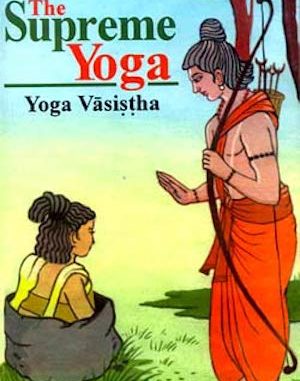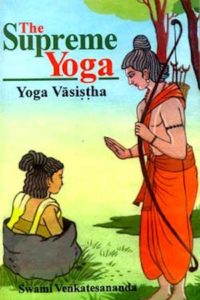
Romola Butalia reviews Swami Venkatesananda’s translation of The Yoga Vasistha, one of the greatest spiritual treatises from Vedanata philosophy. Contained in this are the spiritual teachings that Sri Rama received in his early youth from his guru, the eternal sage Vashishtha.
Title: The Supreme Yoga – Yoga Vashistha
Author: Swami Venkatesanda
Publisher: Motilal Banrsidass
ISBN :81-208-1975-6 (paperback)
Rs. 250 pp:382 pages.
The Yoga Vashishtha is without doubt one of the greatest spiritual treatises of Bharat, the land of the Truth seeker, beyond boundaries of time and place. The most profound metaphysical Truths are conveyed through stories and allegories. Contained in this are the spiritual teachings that Sri Rama received in his early youth from his guru, the eternal sage Vashishtha. The focus of the teachings is that the manifest world is the dream of the soul and we must awaken to the unchanging eternal Reality. Sri Valmiki, to whom the authorship is accredited states, “This world appearance is a confusion, even as the blueness of the sky is an optical illusion. I think it is better not to let the mind dwell on it, but to ignore it.” This, is the simple essence of the teachings, difficult indeed to practice, and yet, the practice thereof is the path to enlightenment.
The Supreme Yoga is a translation and exposition of this well-known Vedanta treatise by Swami Venkatesananda. In this edition, the two volumes of the earlier edition have been compiled conveniently into one volume with a few omissions and modifications. Well presented, each page gives a verse from the chapter in transliteration along with a translation. A summary and exposition of the selected portion flows naturally. It has been compiled as a daily rosary – certainly there is enough to contemplate on when read like this. It is also marked out according to its six chapters. The scriptures are always at different levels, as a simple story and embedded within it, the deeper spiritual significance.
 The first chapter, Vairagya Prakarana is about dispassion, which alone brings clar ity of vision and transformation of the mind. The story begins in Ayodhya, ruled by King Dasharatha, when peace and prosperity prevailed amongst the people. The sons of King Dasharatha returned home from their gurukul. Sri Rama, accompanied by his brothers Lakshmana and Shatrughna, go on an extended teerth yatra or pilgrimage. Sri Rama is overcome by vairagya, a necessary pre-requisite on the spiritual path. To remain established in vairagya, wisdom and samyam or balance and equipoise are the twin pillars. As Sri Valmiki says, “He is qualified to study this scripture who feels, I am bound, I should be liberated.”.
The first chapter, Vairagya Prakarana is about dispassion, which alone brings clar ity of vision and transformation of the mind. The story begins in Ayodhya, ruled by King Dasharatha, when peace and prosperity prevailed amongst the people. The sons of King Dasharatha returned home from their gurukul. Sri Rama, accompanied by his brothers Lakshmana and Shatrughna, go on an extended teerth yatra or pilgrimage. Sri Rama is overcome by vairagya, a necessary pre-requisite on the spiritual path. To remain established in vairagya, wisdom and samyam or balance and equipoise are the twin pillars. As Sri Valmiki says, “He is qualified to study this scripture who feels, I am bound, I should be liberated.”.
The second chapter, Mumuksu Prakaranam, focuses on the behaviour and character of the seeker who becomes a source of inspiration for others. By spontaneously manifesting those attributes of perfection and truth that a human being can associate with, he becomes a source of light for humanity to follow. Sri Rama is the adarsh purush, ideal man. Naturally he is the exemplary spiritual aspirant whose life is an inspiration to seekers. He defines and determines expected behaviour.
The third chapter, Utpatti Prakaranam, explains the origin of the world, how we become involved in the creation of the mind and identify with it. There are several stories in the re-telling of which we are taught to discriminate between the real and the unreal. Possibly best known is the story of King Padma and Queen Lila, who are indeed Vashishth- ji, revered among the Sapt Rishis, with his eternal consort, Arundhati-ji. The goddess Saraswati herself is the witness through whom this is revealed.
In the fourth chapter, Sthiti Prakaranam, having attained that understanding, Sri Rama remains absorbed in the Self, in Brahman. Vashishtha says, “Rama, mind alone is all this: and when that is healed the jugglery of world-appearance is also healed.” Only when firmly established in self-control and tranquility, is the truth of ‘All is Brahman’ revealed.
The fifth chapter, Upasama Prakaranam, deals with dissolution, the inevitable process
determined by creation and existence, which are the subject matter of the two preceding chapters. As Raja Janak reflects to himself, “It is in equanimity that you will experience peace, bliss and the truth.”
The sixth chapter, Nirvana Prakaranam, is the final liberation. Vashishtha says, “They call it Yoga, which is the method by which this cycle of birth and death ceases.” The lofty goals of yoga and its practices are discussed. It must be remembered that yoga is not about mere techniques, but about Atman Bodh or self-realisation. The ancient scriptures have elucidated the techniques in such a way, that they are grasped at different levels according to the spiritual aspirant.
The wisdom Rishi Vasistha shares with his beloved pupil, to remind him who he is, is the divine play through which we mortals are reminded of the Supreme Yoga, the Eternal Truths. Through the medium of the guru-disciple relationship which is one of shaddha and vishwas or faith and belief, the highest spiritual aspirant is able to move from intellectual understanding and intuitive knowledge to the truth and wisdom born of direct experience. Through the revelations of the life and experiences of the sages and great masters, in the Yoga Vasistha, this truth is brought to us through the dialogues of Sri Rama and his guru Vasistha.
There are many translations and expositions of this great treatise, as there are of other ancient Vedanta scriptures. What makes this particular book worth reading is that it is not a mere academic study reflecting skill of translation and knowledge of the subject, but is indeed the sadhana of Swami Venkateshananda, and this is amply reflected in the simplicity, beaut y, purity and joy of expression.
The only deterrent is that the text size is small; an irritant one is obliged to overlook.

Leave a Reply